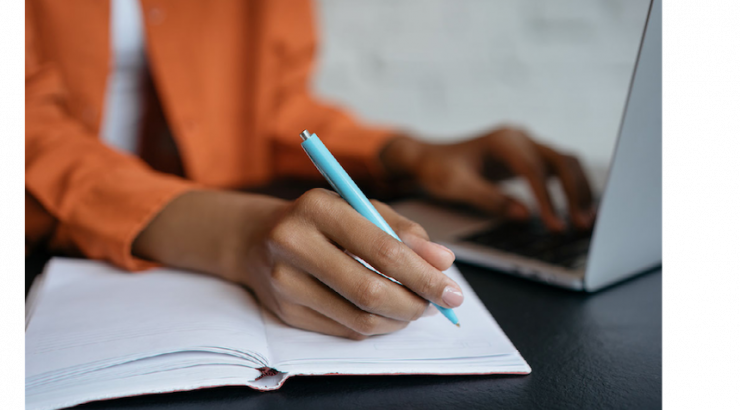
Reflecting, Learning, and Growing How Journals in Canvas Can Transform Your Students' Academic Journey
April 25, 2023
Do you have trouble getting your students to think about what they are learning and why they are learning it? Read on to see how private journals in Canvas can support student reflection.
Neuroeducation applies the scientific method to curricula design and teaching strategies to better understand learning based on evidence of how our brains operate. One evidence-based activity to help students understand what they are learning and why they are learning the material is journal writing. Journal writing allows students to express their thoughts and ideas, boosts critical thinking skills, and increases fluency and creative expression in language usage (Homik, M. & Melis, E., 2006; Pressley et al., 2007). Sousa (2022) advises students to recall prior knowledge through metacognitive practice (the awareness one has of one’s own thinking processes) and reflect on their understanding of the learning objective. Journal writing is a highly effective strategy to promote positive transfer (when past learning helps the learner deal with new learning) and increases retention by using an activity at the end of a lesson (closure activity).
Application in the classroom
Private journals can be done at the end of each class session or once a week, allowing 5-10 minutes to complete their entries. Guidance or prompts may be needed to help students link personal learning with course content. Sousa (2022) suggests asking students to post their responses to these questions for reflective journal entries:
- What did we learn today about [insert here the specific learning objective]? Make sense of the new learning from the learning objective.
- How does this connect or relate to what we already know about [insert here some past learning that will help students with positive transfer]? Chunk new learning into existing networks of past knowledge.
- How can this help us, or how can we use this information/skill in the future? Give hints, if necessary, to aid in finding meaning.
- What could you do to improve? Help decide what needs improving.
Jonassen (2011) suggests incorporating these questions into a virtual learning environment to help students become more self-reflective:
- What are my intellectual strengths and weaknesses?
- How can I motivate myself to learn when I need to?
- How good am I at judging how well I understand something?
- How can I focus on the meaning and significance of new information?
- How can I set specific goals before I begin a task?
- What questions should I ask about the material before I begin?
- How well have I accomplished my goals once I’m finished?
- Have I learned as much as I could once I finished a task?
- Have I considered all options after I solve a problem?
Utilizing Technology for Journal Writing and Feedback
Canvas assignments and discussions can be utilized for private journals. Students can post their digital journal entries, and instructors can provide reach feedback through the speedgrader and annotate with the DocViewer tool. The journals can be integrated with the gradebook by adding a point value.
Please view the two videos on how to create private journals, either for assignment submissions or discussion posts:
Lastly, explore five features of Canvas that can help instructors provide timely, consistent, specific, balanced, and actionable feedback.
Other resources to consider are 7 Research-Based Learning : Perso: Personalrsonal Journal, Dialogue Journal, Highlighted Journal, Key Phrase Journal, Double-entry Journal, Critical Incident Journal, and Three-part Journal.
Research on reflection and learning
The process of memory storage is encoding, storing, and retrieving. Retention requires students to give conscious attention and build conceptual frameworks with a sense and meaning for eventual consolidation into long-term storage networks (Sousa, 2022). Sawyer (2006) discusses designing powerful learning environments; one example is using reflection for students to develop deep conceptual knowledge; they need to reflect thoughtfully and analyze their own work and progress. Jaiswal (2019) did an experimental evaluation of a quantitative study on 26 students’ cognitive capabilities in vocabulary building and retention strategies through instruction designed on cognitive theory. The study was guided by Robert Gangne’s model of nine instructional events and incorporated active learning strategies. Stimulating recall of prior knowledge through writing journals and experimental learning by personalizing information to augment retention and transfer by applying real-world experiences and reflecting on prior knowledge using familiar and unfamiliar vocabulary. The results demonstrate that the learner-centered instructional approach was successful in augmenting the student’s retention and transfer of productive and receptive vocabulary knowledge in language learning.
References
Jaiswal, P. (2019). Using Learner-centered Instructional Approach to Foster Students’ Performances. Theory and Practice in Language Studies, 9(9), 1074. https://doi-org.chapman.idm.oclc.org/10.17507/tpls.0909.02
Jonassen, D. (2011). Supporting Problem Solving in PBL. Interdisciplinary Journal of Problem-Based Learning, 5(2). https://doi.org/10.7771/1541-5015.1256
Homik, M., & Melis, E. (2006). Using blogs for learning logs. Paper presented at the ePortfolio 2006 International Conference. Oxford, UK
Pressley, M., Mohan, L., Raphael, L. M., & Fingeret, L. (2007). How does Bennett Woods Elementary School produce such high reading and writing achievements? Journal of Educational Psychology, 99, 221–240.
Sawyer, R. K. (2006). Introduction: The new science of learning. In R. K. Sawyer (Ed.), The Cambridge handbook of the learning sciences (pp. 1–16). New York, NY: Cambridge.Sousa, D. A. (2022). How the Brain Learns. Corwin Press, Inc.

